The Blitz
Sam - Wootton Upper School
WW2 Home | Fighting
This presentation draws on the evidence of a newspaper correspondent at the time of the London Blitz. It gives us a flavour of what it must have been like to live through bombing raids in a big city.
The appearance of German bombers in the skies over London during the afternoon of September 7, 1940 heralded a tactical shift in Hitler's attempt to subdue Great Britain. During the previous two months, the Luftwaffe had targeted RAF airfields and radar stations for destruction in preparation for the German invasion of the island. With invasion plans put on hold and eventually scrapped, Hitler turned his attention to destroying London in an attempt to demoralize the population and force the British to come to terms. At around 4:00 PM on that September day, 348 German bombers escorted by 617 fighters blasted London until 6:00 PM. Two hours later, guided by the fires set by the first assault, a second group of raiders commenced another attack that lasted until 4:30 the following morning.
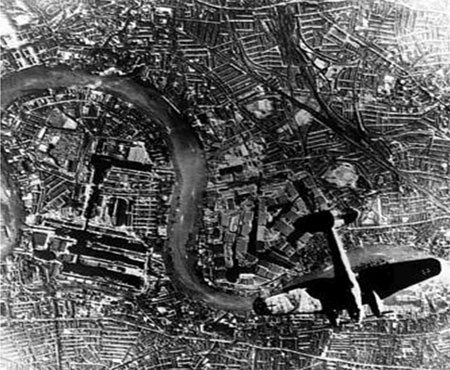
This was the beginning of the Blitz - a period of intense bombing of London and other cities that continued until the following May. For the next consecutive 57 days, London was bombed either during the day or night. Fires consumed many portions of the city. Residents sought shelter wherever they could find it - many fleeing to the Underground stations that sheltered as many as 177,000 people during the night. In the worst single incident, 450 were killed when a bomb destroyed a school being used as an air raid shelter. Londoners and the world were introduced to a new weapon of terror and destruction in the arsenal of twentieth century warfare. The Blitz ended on May 11, 1941 when Hitler called off the raids in order to move his bombers east in preparation for Germany's invasion of Russia.
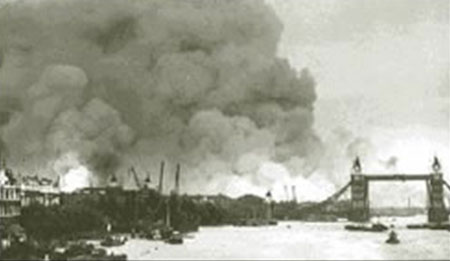
Ernie Pyle was one of World War Two's most popular correspondents. His journalism was characterized by a focus on the common soldier interspersed with sympathy, sensitivity and humour. He witnessed the war in Europe from the Battle of Britain through the invasion of France. In 1945 he accepted assignment to the Pacific Theatre and was killed during the battle for Okinawa. Here, he describes a night raid on London in 1940
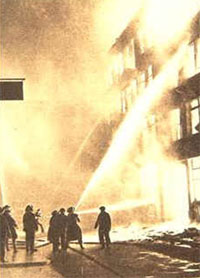 "It
was a night when London was ringed and stabbed with fire. They came just
after dark, and somehow you could sense from the quick, bitter firing of
the guns that there was to be no monkey business this night. Shortly
after the sirens wailed you could hear the Germans grinding overhead. In
my room, with its black curtains drawn across the windows, you could
feel the shake from the guns. You could hear the boom, crump, crump,
crump, of heavy bombs at their work of tearing buildings apart. They
were not too far away.
"It
was a night when London was ringed and stabbed with fire. They came just
after dark, and somehow you could sense from the quick, bitter firing of
the guns that there was to be no monkey business this night. Shortly
after the sirens wailed you could hear the Germans grinding overhead. In
my room, with its black curtains drawn across the windows, you could
feel the shake from the guns. You could hear the boom, crump, crump,
crump, of heavy bombs at their work of tearing buildings apart. They
were not too far away.
Half an hour after the firing started I gathered a couple of friends and
went to a high, darkened balcony that gave us a view of a third of the
entire circle of London. As we stepped out onto the balcony a vast inner
excitement came over all of us-an excitement that had neither fear nor
horror in it, because it was too full of awe.
Half an hour after the firing started I gathered a couple of friends and went to a high, darkened balcony that gave us a view of a third of the entire circle of London. As we stepped out onto the balcony a vast inner excitement came over all of us-an excitement that had neither fear nor horror in it, because it was too full of awe. You have all seen big fires, but I doubt if you have ever seen the whole horizon of a city lined with great fires - scores of them, perhaps hundreds. There was something inspiring just in the awful savagery of it.
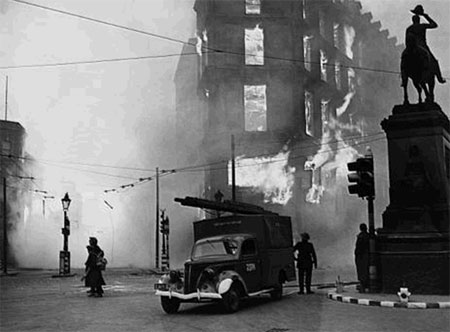
The closest fires were near enough for us to hear the crackling
flames and the yells of firemen. Little fires grew into big ones even
as we watched. Big ones died down under the firemen's valor, only to
break out again later.
About every two minutes a new wave of planes would be over. The motors
seemed to grind rather than roar, and to have an angry pulsation, like a
bee buzzing in blind fury.
The guns did not make a constant overwhelming din as in those
terrible days of September. They were intermittent - sometimes a few
seconds apart, sometimes a minute or more. Their sound was sharp, near
by; and soft and muffled, far away. They were everywhere over London.
Into the dark shadowed spaces below us, while we watched, whole batches
of incendiary bombs fell. We saw two dozen go off in two seconds. They
flashed terrifically, then quickly simmered down to pin points of
dazzling white, burning ferociously. These white pin points would go out
one by one, as the unseen heroes of the moment smothered them with sand.
But also, while we watched, other pin points would burn on, and soon a
yellow flame would leap up from the white center. They had done their
work - another building was on fire.
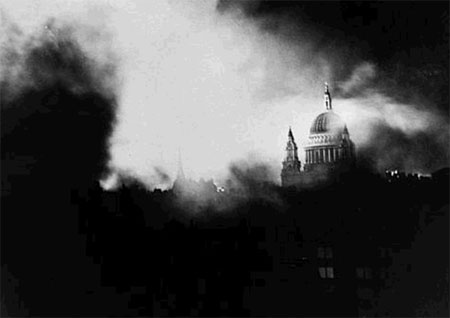
The greatest of all the fires was directly in front of us. Flames seemed to whip hundreds of feet into the air. Pinkish-white smoke ballooned upward in a great cloud, and out of this cloud there gradually took shape - so faintly at first that we weren't sure we saw correctly - the gigantic dome of St. Paul's Cathedral. St. Paul's was surrounded by fire, but it came through. It stood there in its enormous proportions - growing slowly clearer and clearer, the way objects take shape at dawn. It was like a picture of some miraculous figure that appears before peace-hungry soldiers on a battlefield.
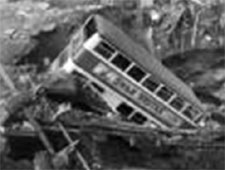 The streets below us were semi-illuminated from the glow.
Immediately above the firesthe sky was red and angry, and overhead,
making a ceiling in the vast heavens, there was a cloud of smoke all in
pink. Up in that pink shrouding there were tiny, brilliant specks of
flashing light-antiaircraft shells bursting. After the flash you could
hear the sound
The streets below us were semi-illuminated from the glow.
Immediately above the firesthe sky was red and angry, and overhead,
making a ceiling in the vast heavens, there was a cloud of smoke all in
pink. Up in that pink shrouding there were tiny, brilliant specks of
flashing light-antiaircraft shells bursting. After the flash you could
hear the sound
The barrage balloons were standing out as clearly as if it were daytime. They were pink instead of silver. And now and then through a hole in that pink shroud there twinkled incongruously a permanent, genuine star - the old - fashioned kind that has always been there. Below us the Thames grew lighter, and all around below were the shadows - the dark shadows of buildings and bridges that formed the base of this dreadful masterpiece
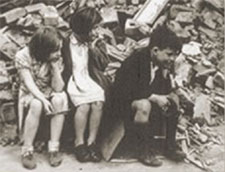 Later
on I borrowed a tin hat and went out among the fires. That was exciting
too; but the thing I shall always remember above all the other things in
my life is the monstrous loveliness of that one single view of London on
a holiday night - London stabbed with great fires, shaken by explosions,
its dark regions along the Thames sparkling with the pin points of
white-hot bombs, all of it roofed over with a ceiling of pink that held
bursting shells, balloons, flares and the grind of vicious engines. And
in yourself the excitement and anticipation and wonder in your soul that
this could be happening at all.
Later
on I borrowed a tin hat and went out among the fires. That was exciting
too; but the thing I shall always remember above all the other things in
my life is the monstrous loveliness of that one single view of London on
a holiday night - London stabbed with great fires, shaken by explosions,
its dark regions along the Thames sparkling with the pin points of
white-hot bombs, all of it roofed over with a ceiling of pink that held
bursting shells, balloons, flares and the grind of vicious engines. And
in yourself the excitement and anticipation and wonder in your soul that
this could be happening at all.
These things all went together to make the most hateful, most beautiful
single scene I have ever known."
WW2 Home | Fighting
Page last updated: 25th February 2014
